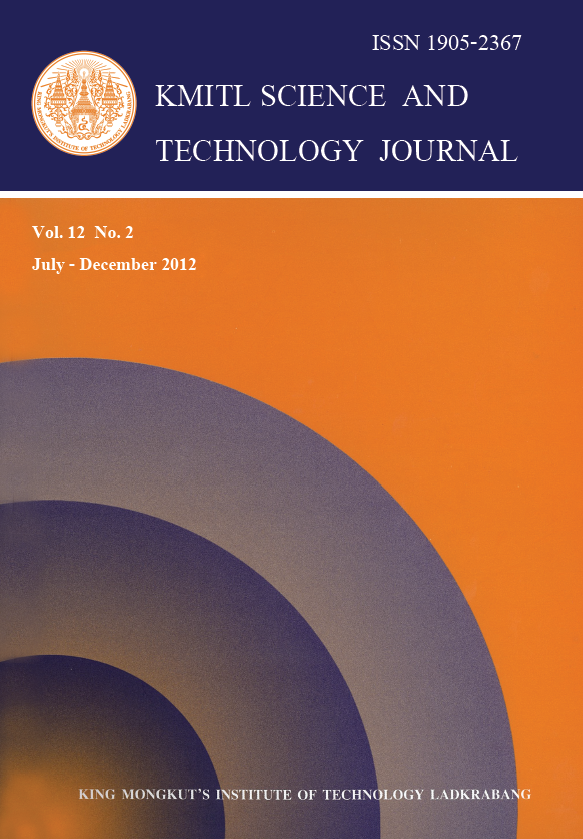An SIR Epidemic Model with Gravity in Patchy Environment: Analyses for Two Patches System
Main Article Content
Abstract
In this study, we propose an explicitly spatial SIR epidemic model under which a population travel is subject to the gravity law. Namely, the migration rates are assumed to be increased with the populations between coupled patches and decreased with the distance. We analyze the model simplified into two patches. The conditions for a stable disease-free equilibrium are derived. Moreover, we show that the derived basic reproduction number corresponds with such conditions. The numerical results shown are in agreement with theory.
Keywords: SIR epidemic model, Gravity model, Asymptotic stability
E-mail: klot@su.ac.th
Article Details
Copyright Transfer Statement
The copyright of this article is transferred to Current Applied Science and Technology journal with effect if and when the article is accepted for publication. The copyright transfer covers the exclusive right to reproduce and distribute the article, including reprints, translations, photographic reproductions, electronic form (offline, online) or any other reproductions of similar nature.
The author warrants that this contribution is original and that he/she has full power to make this grant. The author signs for and accepts responsibility for releasing this material on behalf of any and all co-authors.
Here is the link for download: Copyright transfer form.pdf
References
[2] Hufnagel, L., Brockmann, D. and Geisel, T. 2004. Forecast and control of epidemics in a globalized world. PNAS, 101(42), 15124-15129.
[3] Brockmann, D. 2010. Human mobility and spatial disease dynamics, in Reviews of Nonlinear Dynamics and Complexity, Volume 2 (ed H. G. Schuster), Wiley-VCH Verlag GmbH & Co. KGaA, Weinheim, Germany. doi: 10.1002/9783527628001.ch1.
[4] Lloyd, A. L. and May, R. M. 1996. Spatial heterogeneity in epidemic models. Journal of Theoretical Biology, 179(1), 1-11.
[5] Lloyd, A. L. and Jansen, V. A. A. 2004. Spatiotemporal dynamics of epidemics: synchrony in metapopulation models. Mathematical Biosciences,188, 1-16.
[6] Keeling, M. J. and Rohani, P. 2002. Estimating spatial coupling in epidemiological systems:a mechanistic approach. Ecology Letters, 5, 20-29.
[7] Hagenaars, T. J., Donnelly, C. A. and Ferguson, N. M., 2004. Spatial heterogeneity and the persistence of infectious diseases. J. Theor. Biol., 229(3), 349-359.
[8] Gonz´alez, M.C., Hidalgo, C.A. and Barab´asi, A.L. 2008. Understanding individual human mobility patterns. Nature, 453, 479-482.
[9] Xia, Y., Bjornstad, O.N. and Grenfell, B.T. 2004. Measles metapopulation dynamics: a gravity model for epidemiological coupling and dynamics. The American Naturalist, 164(2),267-281.
[10] Lloyd, A.L. and Sattenspiel, L. 2010. Spatiotemporal dynamics of measles: Synchrony and persistence in a disease metapopulation, In Mathematical and Computational Biology Series,(ed S. cantrell), CRC Press, 251-271.
[11] Heffernan, J.M., Smith, R. J. and Wahl, L.M. 2005. Perspectives on the basic reproductive ratio. J R Soc Interface, 2(4), 281-293.
[12] Diekmann, O. and Heesterbeek, J. A. P. 2000. Mathematical Epidemiology of Infectious Diseases. Wiley series in mathematical and computation biology, Wiley.
[13] Diekmann, O., Heesterbeek, J. A. P. and Metz, J. A. J. 1990. On the definition and the computation of the basic reproduction ratio R0 in models for infectious diseases in heterogeneous populations. J. Math. Biol., 28, 365-382.
[14] Driessche, P. van den and Watmough, J. 2002. Reproduction numbers and sub-threshold endemic equilibria for compartmental models of disease transmission. Math. Biosci., 180,29-48.


